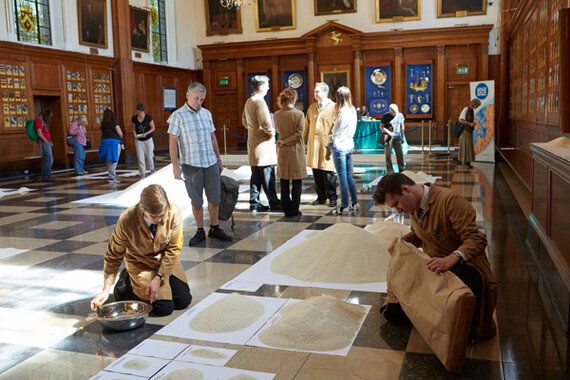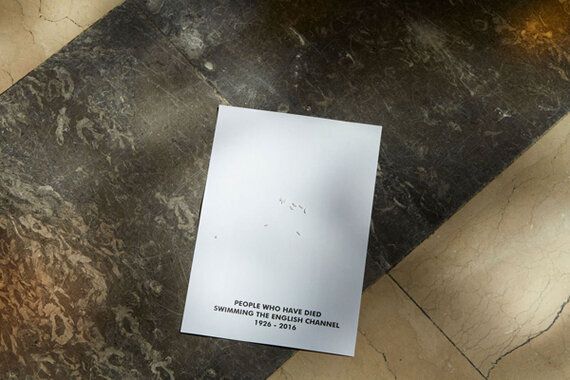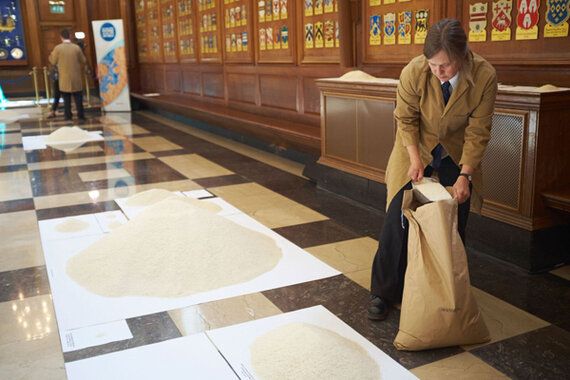Among the artistic events co-ordinated by the Artichoke company for their current London's Burning festival to commemorate the 350th anniversary of the Great Fire of London is one focusing on statistics. Dry and boring you might think.
So, to make it interesting, they commissioned the performance group Stan's Cafe (named after the venue in Birmingham in which the company was conceived) to bring stats to life by visually representing them through grains of rice, something they've been doing across Europe on various themes for 13 years.
The result is a succession of neat piles of rice of various sizes placed on white paper on the floor of the hall at the Inner Temple under the watchful, stern portraits of four of the five Fire Judges appointed by King Charles II to adjudicate on compensation claims after the Fire.

Each grain of rice represents one person and among the single grains featured is that of Thomas Farriner whose bakery on Pudding Lane was the source of the blaze on 2 September 1666.
Another tiny pile, of six grains, represents the official death toll of the fire though the organisers might have added a pinch of salt as official records did not include the poor.
Neither would they have included the foreign victims of lynch mobs who believed the rumours that the fire was a plot to overthrow the country. We were at war with the Dutch at the time.
Much bigger piles denote the population of the City of London (ie within the old Roman walls) at the time around 80,000, a sixth of London's inhabitants and nearby a similarly-sized pile representing the 70,000 who were displaced. This would accrue to some two million people in today's terms.
The Great Fire's savage progress over four days was made easier not only by the predominance of wooden structures but also by the highly inflammable oil, tar and other combustibles to be found everywhere on the wharfs.
Most of the victims were allowed to set up temporary shelters in fields owned by the City of London Corporation in Highbury, Islington and in Moorfields. The wretched conditions were exacerbated by profiteers who saw a chance to sell their goods to the desperate at inflated prices. No change there then.
King Charles II, another one grainer, was worried that the displaced might rise up in rebellion since it was not long ago that London had supported Cromwell during the civil war that cost the King's father his head.
The installation does not, however, restrict its visual statistics to the Great Fire but seeks parallels with more contemporary events.

One of the biggest piles denotes the number of refugees in the world, defined by the UNHCR as those who have crossed borders. Stan's Cafe would have liked to have made a pile representing the world's internally displaced people i.e. those who have not crossed a border. But as associate artist Jack Trow explained, "at 65 million people it was too much rice for the load limit of the Inner Temple Hall". A chilling thought.
The artwork contains two tons of rice. If they were to include a grain to represent its title, they's require 120 tons.
The biggest pile of rice on show here represents the number of people who voted in the recent EU referendum. A pile about half the size represented those who didn't.
The work is full of random items. A large pile denotes the number of people who watched episode 1, series 7 of The Great British Bake Off. Equally current is a not too small pile entitled Newly qualified primary school teachers in Ireland who could be paid for one year with back taxes owed by Apple.

The installation is a performance art in that the brown-coated artists will act on suggestions by members of the public for certain statistics, and, once verified, will carefully create a new pile of rice. The installation thus evolves.
The problem with it as a whole is that, thought-provoking though it might be, statistics whether visually presented or not, require context. The number of soldiers killed on the first day of the Battle of the Somme makes a tiny pile compared to the number of people employed by the NHS and so the impact is lost.
However, there's a certain aesthetic quality about the rice piles placed simply in an ornate setting, one that managed to survive the ravages of the Great Fire.
The images are used with the permission of Matthew Andrews.